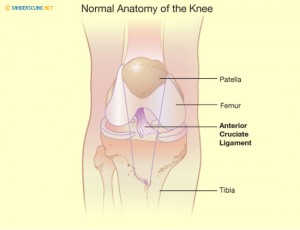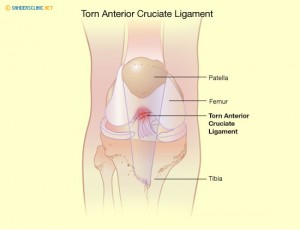What Patients Are Asking About ACL Surgery
This blog is dedicated to answering many of the questions we’ve received regarding Anterior Cruciate Ligament (ACL) reconstruction. These are Dr. Sanders’ recommendations for those contemplating this procedure.


Recommendations
1. Aggressive presurgical rehabilitation emphasizing normal gait without braces or crutches, normal leg control, full range of motion, especially hyperextension equal to the opposite leg.
2. Surveillance for ubiquitous Vitamin D deficiency and of nasal staph infection. Presurgical treatment for these conditions to hasten bone healing and avoidance of wound infection. Surveillance for other lower extremity disorders is performed which will make reconstruction failure more likely, such other concurrent ligametous injuries, and limb deformities. An objective measurement of knee laxity is obtained by use of the KT-1000 Arthrometer.
3. Less traumatic surgical exposure avoiding medial (inside of the midline) incisions and subsequent chronic knee pain from saphaneous nerve injury.
4. Anatomic placement of bone tunnels is a cinch with the knee is flexed to 140 degrees, whereas misplacement of the tunnels is a common mistake with the knee is only flexed 90 degrees as with traditional arthroscopic techniques which leads to stiffness and/or recurrent instability.
5. Avoidance of medial and/or lateral menisectomy which will lead to increased knee laxity, post traumatic arthritis or both. When necessary, the meniscus will be repaired rather than removed. Post surgical rehabilitation is not altered in these cases.
6. Reconstruction with autologous (patient’s own) patella or quadriceps tendon, ideally from the opposite side, with a three to four percent graft failure rate. Hamstring tendons are not utilized because of subsequent hamstring weakness that is not amenable to post surgical rehabilitation, and failure rate between five to10 percent. Allografts are not utilized because of their 20-25 percent failure rate – as well as their expense of nearly $4000 USD.
7. Stable minimally traumatic fixation of the graft with buttons and/or hitching post, such that immediate normal ambulation and rehab is started. Intra osseous hardware for graft fixation is avoided, such that in the event of revision surgery, a separate bone grafting procedure prior to revision reconstruction is not necessary.
8. Less traumatic reconstruction of the Anterolateral Knee Tibiofemoral Ligament (“New knee ligament,” also known as extra articular reconstruction) that will leave the knee with increased stability to well tolerate accelerated rehabilitation, return to sports, and buttress against new injuries.
9. Avoidance of the post surgical femoral nerve block that carries high likelihood of post surgical pain and quadriceps weakness lasting in excess of three months.
10. Saphaneous nerve block in combination with infiltration of local anesthesia, and multimodal pain management allows a nearly pain free first 24 hours with minimal sequelae of the nerve block. Multimodal analgesia afterwards will minimize need for narcotic medicines, while keeping patients comfortable enough to perform their rehabilitation without undue discomfort.
11. Immediate active Range of Motion exercises, without need for CPM machine, emphasizing symmetric motion of both limbs (regardless of graft choice) and ambulation without crutches or braces allows for decrease, yes decrease, of post surgical pain, faster rehabilitation, and avoidance of secondary operations for removal of scar tissue without increasing the likelihood of graft failure.
12. In cases where the tendon graft is taken from the opposite side, rehabilitation is considerably easier, more rapid and less painful, as each limb is exercised concurrently: for strength on the graft side, and range of motion and agility on the ACL side, rather than one limb undergoing two consecutive rehabilitation programs. Patients are safe to return to sports as early as three months post surgery without increased likelihood of graft rupture.
13. I also commonly take the graft from the same side as some folks can’t seem to wrap themselves around the idea of a graft from the opposite knee. Rehab in these cases is still highly satisfactory, when compared to average programs, but occurs at about 2/3rds speed. Return to sports between four and six months is expected.
Selecting an ACL reconstruction method and an Orthopaedic surgeon is neither an easy task for the lay person or a physician. In today’s times, ACL patients have many choices, even though many of them are not backed by proven results and evidence based medicine. Unfortunately, most of these choices are made for the “convenience” of the patient or surgeon. Like many things in the human experience, the “easy way out” more often than not turns out to be the “harder way” leading to the heart break of surgical failures and further operations.
Key components in selecting the right Orthopaedic surgeon include:
Board Certification
Subspecialty Certification
Professional Association Membership
Invited Memberships
Published research in peer reviewed journals
